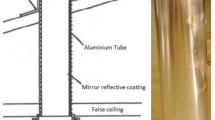Abstract
Simulation with two types of bi-directional scattering distribution function (BSDF) was used to model the prism daylight redirecting fenestration (PDRF) in the indoor luminous environment. A goniophotometer was used to develop two different BSDF data sets: Klems data and Tensor tree data. Coefficient of determination and linear regression of the illuminance values with Klems and Tensor tree BSDF data were analyzed at low, medium, and high solar altitudes under Perez sky models with various sky conditions. The comparisons indicate that the Klems and Tensor tree angular data of PDRF materials show strong correlations and good linear regression relationships in general with PDRF daylighting clerestories. The study results demonstrated that using measured Klems data for combined daylighting and energy simulation of PDRF system is feasible as the simulated illuminance levels with Klems and Tensor tree data are similar under Perez sky conditions. The simulation results also showed that the PDRF daylighting windows above vision windows increase the work plane illuminance (WPI) opposite the window wall under clear sky conditions.
Similar content being viewed by others
References
Andersen M, Rubin M, Scartezzini J-L (2003). Comparison between ray-tracing simulations and bi-directional transmission measurements on prismatic glazing. Solar Energy, 74: 157–173.
Andersen M (2004). Innovative bidirectional video-goniophotometer for advanced fenestration systems. PhD Thesis, Ecole Polytechnique Federal de Lausanne, Switzerland.
Atif MR, Love JA, Littlefair P (1997). Daylighting monitoring protocols & procedures for buildings. A report of Task 21/Annex 29 Daylight in Buildings. National Research Council Canada, Ottawa, Canada.
Duffy JF, Czeisler CA (2009). Effect of light on human circadian physiology. Sleep Medicine Clinics, 4: 165–177.
gendaylit (2019). Available at https://www.radiance-online.org/learning/documentation/manual-pages/pdfs/gendaylit.pdf. Accessed on 10 Mar. 2019.
HesChong Mahone Group (2003). Windows and classrooms: a study of student performance and the indoor environment. Sacramento, CA, USA: California Energy Commission.
Hoffmann S, Lee ES, McNeil A, Fernandes L, Vidanovic D, Thanachareonkit A (2016). Balancing daylight, glare, and energyefficiency goals: An evaluation of exterior coplanar shading systems using complex fenestration modeling tools. Energy and Buildings, 112: 279–298.
IEA (2000). Daylight in buildings: A Source Book on Daylighting Systems and Components. LBNL-47493. Berkeley, CA, USA: Lawrence Berkeley National Laboratory.
Klems JH (1994). A new method for predicting the solar heat gain of complex fenestration systems: I. Overview and derivation of the matrix layer calculation. ASHRAE Transactions, 100(1): 1073–1086.
LBNL (2019). BSDFViewer, Version1.2. Available at https://www.radiance-online.org/download-install/third-partyutilities/bsdf-viewer. Accessed on 25 Aug. 2019.
Lee ES, Geisler-Moroder D, Ward G (2018). Modeling the direct sun component in buildings using matrix algebraic approaches: Methods and validation. Solar Energy, 160: 380–395.
Mashaly IA, Nassar K, El-Haggar S (2018). Mathematical model for designing a light redirecting prismatic panel. Solar Energy, 159: 638–649.
McNeil A, Jonsson CJ, Appelfeld D, Ward G, Lee ES (2013). A validation of a ray-tracing tool used to generate bi-directional scattering distribution functions for complex fenestration systems. Solar Energy, 98: 404–414.
McNeil A, Lee ES, Jonsson JC (2017). Daylight performance of a microstructured prismatic window film in deep open plan offices. Building and Environment, 113: 280–297.
Molina G, Bustamante W, Rao J, Fazio P, Vera S (2015). Evaluation of radiance’s genBSDF capability to assess solar bidirectional properties of complex fenestration systems. Journal of Building Performance Simulation, 8: 216–225.
Perez R, Seals R, Michalsky J (1993). All-weather model for sky luminance distribution—Preliminary configuration and validation. Solar Energy, 50: 235–245.
Robinson A, Selkowitz S (2013). Tips for daylighting with windows environmental energy technologies division. Berkeley, CA, USA: Lawrence Berkeley National Laboratory.
Santos L, Leitão A, Caldas L (2018). A comparison of two lightredirecting fenestration systems using a modified modeling technique for Radiance 3-phase method simulations. Solar Energy, 161: 47–63.
Stover JC (1995). Optical Scattering: Measurement and Analysis, 2nd edn. Bellingham, WA, USA: SPIE.
Tian Z, Lei Y, Jonsson JC (2019). Daylight luminous environment with prismatic film glazing in deep depth manufacture buildings. Building Simulation, 12: 129–140.
Tian Z, Lin P, He Y, Jonsson JC (2020). A study of luminous environment with prism daylight redirecting fenestrations in classrooms. Indoor and Built Environment, https://doi.org/10.1177/1420326X19895566
Acknowledgements
The research is funded by the National Natural Science Foundation of China (Grant No. 51978429), Suzhou Municipal Research Project (SS201730), and Suzhou Building and Construction System Research Project (201904). The work is also part of the International Energy Agency (IEA) SHC IEA Task 61/EBC Annex 77 research project. The authors also thank Prof. James Love at the University of Calgary, Canada for his help in this study.
Author information
Authors and Affiliations
Corresponding author
Additional information
This is a U.S. government work and not under copyright protection in the U.S.; foreign copyright protection may apply 2020
Rights and permissions
About this article
Cite this article
Lin, P., Tian, Z. & Jonsson, J.C. Analysis of the performance of prism daylight redirecting systems with bi-directional scattering distribution functions. Build. Simul. 13, 305–316 (2020). https://doi.org/10.1007/s12273-020-0607-4
Received:
Revised:
Accepted:
Published:
Issue Date:
DOI: https://doi.org/10.1007/s12273-020-0607-4




